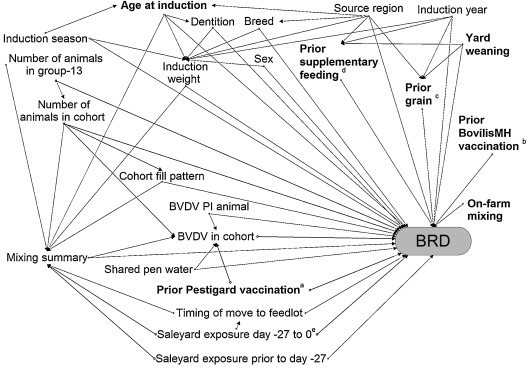Preconditioning refers to the process of preparing weaned calves destined for fattening over a period of time (Hentzen et al. 2020). The preconditioning process is designed to improve a calf's chances of dealing with future stressors and pathogens. It is about strengthening and managing the immune system, controlling stress and preventing excessive exposure to pathogens during this short period of transition from suckling calf to weaned calf. Newly weaned, uncastrated or not dehorned calves, as well as calves that have been transported through an auction market or calves that have not received vaccinations (BVD or MH) are usually at the highest risk for respiratory disease (Wilson et al. 2017, Hay et al. 2016). And these infections are the main cause of losses in weaned calves. Calves that have fewer health problems require less medication, suffer fewer deaths, are more productive and have potentially higher quality carcasses.
 Hay et al. (2016) Causal diagram depicting pathways relevant for the determination of total and direct effects of putative risk factors for bovine respiratory disease (BRD) in feedlot cattle
Hay et al. (2016) Causal diagram depicting pathways relevant for the determination of total and direct effects of putative risk factors for bovine respiratory disease (BRD) in feedlot cattlePreconditioning programmes differ, for example, in the duration (14 days up to 45 days), in which vaccinations are carried out and how the animals are fed (farm feed, purchased feed), but also the weight gain in this phase can vary greatly. It is important to include all these points in the pricing with the buyer. One example of a preconditioning programme is the Vac-45 of the Oklahoma Quality Beef Network (OQBN). The certification promises less stress on the animals, an improved immune system, higher sales weight as well as higher market demand. OQBN is a joint project of the Oklahoma Cooperative Extension Service and the Oklahoma Cattlemen's Association (OCA). To be eligible for the OQBN's Vac-45 program, calves must meet the following health and management requirements:
- Bull calves must be castrated and healed
- all calves must be dehorned and healed
- calves must be weaned for at least 45 days
- the beef quality assurance guidelines must be complied with
- Calves must be ear-tagged in accordance with the programme.
- Calves must be on one of the three specified vaccination protocols.
Vaccination programmes increase resistance and immunity to viruses and other pathogens before a health problem occurs. Critical to a successful health programme is that the correct vaccines are administered correctly and that sufficient time is allowed for immunity to establish in an environment where stress levels are reduced. Therefore, the following options exist for the timing of vaccination:
- vaccination at branding and weaning
- vaccination pre-weaning and post-weaning
- vaccination at weaning and post-weaning
Furthermore, in order to improve the general health of the herd, it is recommended to
- Deworm and treat for external parasites
- Provide abundant, clean and fresh water at all times
- Provide abundant high quality grass hay or pasture
- Feed concentrate supplement for a minimum of seven days after weaning to train cattle to eat from a bunk and come to feed
- Provide free choice mineral supplementation
- Provide a coccidiostat through the feed, water or mineral
For further information:
- The effect of preconditioning: http://oqbn.okstate.edu/Extension%20Fact%20Sheets/Effects%20of%20Preconditioning.pdf
- Overview of different preconditioning programs: http://www.beefstockerusa.org/preconditioning/surveys/pfizer.html
Source:
- McCollum, T.; Gill, R. (2000): Preconditioning Pointers. URL: https://www.beefmagazine.com/mag/beef_preconditioning_pointers#comment-0
- Hentzen, A. H. R.; Thompson, P. N.; Holm, D. E. (2020): The effect of preconditioning on production and antibiotic use in a South African beef feedlot. Animal Production Science 60 (15). https://www.publish.csiro.au/an/AN19495
- Hay, K. E. et al. (2016): Associations between prior management of cattle and risk of bovine respiratory disease in feedlot cattle. Preventive Veterinary Medicine, 127. https://www.sciencedirect.com/science/article/pii/S0167587716300708?via%3Dihub
- Wilson, B.K. et al. (2017): Best management practices for newly weaned calves for improved health and well-being. Journal of Animal Science 95(5). Doi: 10.2527/jas.2016.1006
- Oklahoma State University. Oklahoma Quality Beef Network (2022) (visited May 2022) http://oqbn.okstate.edu/oqbn-vac-45
Impact:
- Socioeconomic Resilience: Preconditioning involves additional costs, but can also be a gain.
- Animal Health and Welfare: Good preparation for the stressful situations of transport and start of fattening has a positive impact on animal health.
- Production Efficiency and Meat Quality: Better development of preconditioned animals makes their fattening more efficient.
- Environmental Sustainability: Healthier animals have better feed conversion, thus conserving resources.